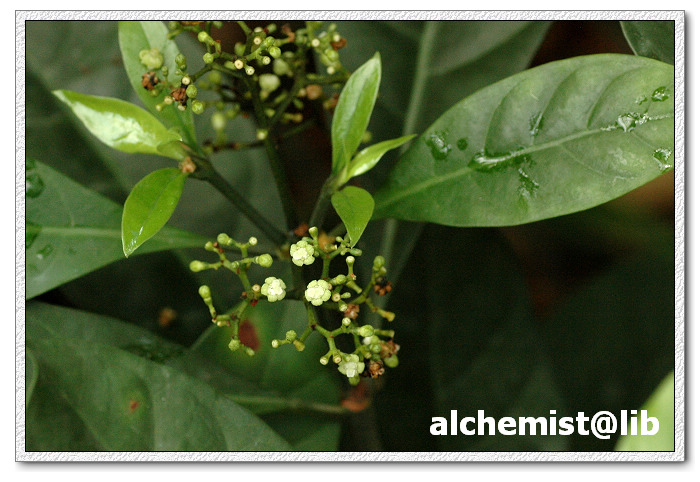- Scientific Name: Psychotria asiatica L.
- Ref: Syst. Nat. ed. 10, 2:929. 1759
- Synonyms: Antherura rubra Lour.; Aucubaephyllum lioukiense Ahlb.; Polyozus lanceolata Lour.; Psychotria antherura Schult.; P. esquirolii H.Lév.; P. reevesii Wall.; P. rubra (Lour.) Poir.; P. rubra var. pilosa (Pit.) W.C.Chen; Psychotrophum asiaticum (L.) Crantz; Uragoga rubra (Lour.) Kuntze
- Chinese Common Name: 九节 jiǔjiē
- Japanese Common Name: ボチョウジ bochōji, リュウキュウアオキ [琉球青木] ryūkyūaoki
- Family: Rubiaceae
- Genus: Psychotria
- Distribution: Thickets or forests in ravines, on hill slopes, or at village margins; near sea level to 1500 m. Fujian, Guangdong, Guangxi, Guizhou, Hainan, Hunan, Taiwan, Yunnan, Zhejiang, also cultivated in Zhejiang [Cambodia, India, Japan, Laos (commonly collected), Malaysia, Thailand, Vietnam (very commonly collected)].
- Photo: 06/21/2009, South China Botanical Garden, Guangdong
Shrubs or small trees, 0.5-5 m tall; stems puberulent to glabrous. Petiole 0.7-5 cm, glabrous or rarely puberulent; leaf blade reportedly rather shiny in life, drying papery to leathery, dark red, brownish red, yellowish green, or gray-green, elliptic-oblong, lanceolate-oblong, or rarely oblong-ovate, 5-23.5 × 2-9 cm, adaxially glabrous, abaxially glabrous or puberulent, base acute to obtuse, margins flat to narrowly revolute, apex acute to acuminate or obtuse then abruptly narrowed and acuminate; secondary veins 5-8(-11) pairs, free or weakly forming a broadly looping, incomplete submarginal vein, usually with foveolate and sometimes pilosulous domatia; stipules caducous or sometimes persisting on 2 or 3 nodes, triangular to broadly triangular or broadly ligulate, interpetiolar or shortly united around stem, [3-]6-8 mm, glabrous to puberulent, broadly rounded to obtuse or shallowly emarginate. Inflorescences terminal or sometimes pseudoaxillary, cymose to paniculiform, many flowered, glabrous or usually densely puberulent, sessile and apparently tripartite to shortly pedunculate; peduncle to 0.3 mm; branched portion corymbiform-rounded to broadly pyramidal, 2-10 × 3-5 cm, with 1-3 pairs of developed secondary axes; bracts triangular, 0.2-1 mm; pedicels to 2.5 mm. Flowers subsessile to pedicellate in dichotomous cymules of 3-5. Calyx densely puberulent; hypanthium portion turbinate, 0.8-1.2 mm; limb 0.8-1 mm, subtruncate to denticulate. Corolla white, funnelform, glabrous outside; tube 2-3 mm, in throat white villous; lobes triangular, 2-2.5 mm. Drupes red, subglobose to broadly ellipsoid, 5-8 × 4-7 mm, with pedicels to 10 mm; pyrenes shallowly 3-5-ribbed. Fl. and fr. year-round. (Flora of China)
